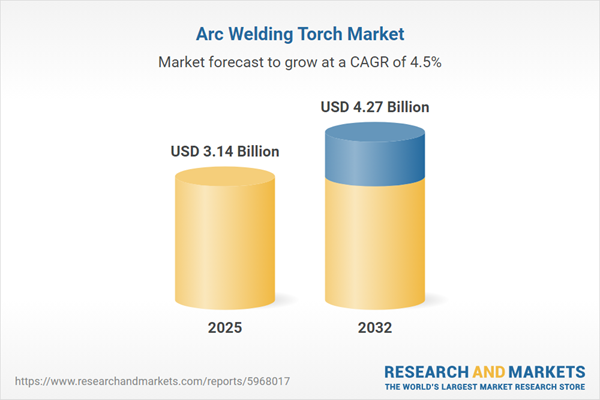Speak directly to the analyst to clarify any post sales queries you may have.
The arc welding torch market is evolving as organizations across manufacturing, energy, and infrastructure seek smarter, safer, and more adaptable solutions. Senior executives require timely market intelligence and technology insights to steer operational strategies and maintain competitive momentum amid rapid industry transformation.
Market Snapshot: Arc Welding Torch Market Size and Growth
In 2024, the global arc welding torch market achieved a valuation of USD 3 billion. Analysts project a compound annual growth rate of 4.52%, anticipating the market will expand to USD 3.14 billion in 2025 and USD 4.27 billion by 2032. This growth trajectory is powered by widespread adoption of automated welding systems, continued innovation, and a sustained focus on process efficiency. Core sectors, including automotive, energy, and heavy industry, are leveraging advanced arc welding torch solutions to optimize their production. Strategic investments in technology and responsive regulatory practices are reinforcing market expansion and driving global deployment of both established and new torch models.
Scope & Segmentation of the Arc Welding Torch Market
- Welding Processes: Includes flux-cored arc, metal inert gas, shielded metal arc, and tungsten inert gas welding, each designed to address varying manufacturing demands and accommodate a wide range of assembly complexities.
- End Users: Automotive OEMs, construction companies, oil and gas sectors, shipbuilders, and defense agencies, all characterized by specific compliance needs and unique operational criteria for equipment selection.
- Automation Level: Encompasses CNC-controlled, PLC-controlled, robot-assisted, and manual configurations, supporting both high-throughput operations and niche production scenarios.
- Cooling Methods: Solutions include forced air, passive air, closed-loop water, and open-loop water cooling, designed to prolong system life and guarantee stable performance under heavy-duty conditions.
- Torch Types: Features both handheld and mechanized options, granting flexibility for both stationary factory tasks and remote, mobile applications where adaptability is critical.
- Current Types: Offers alternating as well as direct current operation to address changing material requirements and structural expectations.
- Applications: Supports fabrication, general manufacturing, and maintenance, ensuring resource efficiency and workflow continuity across diverse industrial environments.
- Regions: With presence in the Americas, Europe, Middle East, Africa, and Asia-Pacific, regional players in countries like the United States, China, Germany, Japan, Brazil, and India actively shape innovation and compliance standards.
- Leading Companies: Prominent firms such as Lincoln Electric Holdings, Illinois Tool Works, ESAB AB, Fronius International, Panasonic, EWM AG, Kemppi Oy, Daihen Corporation, Rilon Welding & Cutting Technologies, and Air Liquide SA emphasize R&D and broadened product portfolios to address evolving market needs.
Key Takeaways for Senior Decision-Makers
- Advanced torch designs with improved materials help organizations strengthen safety protocols, allowing operational reliability in more demanding environments.
- Integration of digital monitoring and predictive maintenance supports a data-driven approach, minimizing disruptions and enabling smarter downtime planning.
- Customizable and modular torch solutions allow manufacturers to adapt quickly to shifting production demands, streamlining retooling and site upgrades when priorities change.
- Optimized supplier relationships, including local sourcing and tailored inventory management, mitigate risks associated with volatile supply chains and changing regulations.
- Collaborative industry partnerships facilitate the development of uniform regulatory standards and foster efficiencies in manufacturing and distribution networks.
Tariff Impact: Navigating U.S. Trade and Supply Chain Adjustments
Recent changes in U.S. tariff policies prompt key market participants to reassess sourcing and distribution strategies for arc welding torches. Strengthening connections with suppliers, expanding procurement within targeted regions, and implementing robust inventory management are critical responses to market volatility. Consistent dialogue with stakeholders underpins resilience and operational continuity amid evolving trade regulations.
Methodology & Data Sources
This analysis integrates interviews with senior executives, select industry surveys, and direct input from leading arc welding torch manufacturers and professional associations. Standard frameworks, including Porter’s Five Forces and SWOT, validate the findings to ensure recommendations are actionable and industry-relevant.
Why This Report Matters
- Equips leadership to anticipate market shifts and regulatory updates using actionable insights tailored for the arc welding torch market.
- Supports the development of resilient, adaptable manufacturing strategies to address supply chain complexity and workforce evolution.
- Provides executives with reliable analytical frameworks to assess strategic risks and capitalize on sector transformation opportunities.
Conclusion
Effective participation in the arc welding torch market calls for a combination of forward-thinking strategy, focused intelligence, and ongoing investment in advanced automation and digital technologies. Organizations positioned with accurate market insights can drive innovation and ensure robust, sustainable growth.
Additional Product Information:
- Purchase of this report includes 1 year online access with quarterly updates.
- This report can be updated on request. Please contact our Customer Experience team using the Ask a Question widget on our website.
Table of Contents
3. Executive Summary
4. Market Overview
7. Cumulative Impact of Artificial Intelligence 2025
Companies Mentioned
The companies profiled in this Arc Welding Torch market report include:- Lincoln Electric Holdings, Inc.
- Illinois Tool Works Inc.
- ESAB AB
- Fronius International GmbH
- Panasonic Corporation
- EWM AG
- Kemppi Oy
- Daihen Corporation
- Rilon Welding & Cutting Technologies, Inc.
- Air Liquide SA
Table Information
| Report Attribute | Details |
|---|---|
| No. of Pages | 183 |
| Published | October 2025 |
| Forecast Period | 2025 - 2032 |
| Estimated Market Value ( USD | $ 3.14 Billion |
| Forecasted Market Value ( USD | $ 4.27 Billion |
| Compound Annual Growth Rate | 4.5% |
| Regions Covered | Global |
| No. of Companies Mentioned | 11 |









